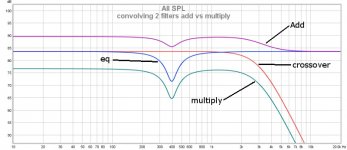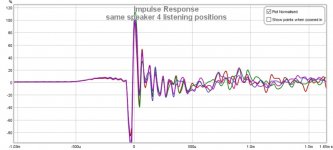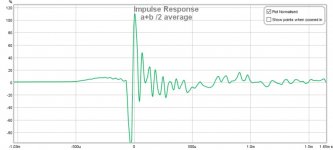The adding part may be a little confusing.
In reality the complex values on each frequency are multiplied. Then both the magnitude and phase is acounted for. Then magnitude is converted to dB and shown in the SPL window. Here REW author has chosen en to call it ADD, even if it is only the magnitude in SPL that can be added
The phase is also taken account for, but it is not added🙂
In reality the complex values on each frequency are multiplied. Then both the magnitude and phase is acounted for. Then magnitude is converted to dB and shown in the SPL window. Here REW author has chosen en to call it ADD, even if it is only the magnitude in SPL that can be added
The phase is also taken account for, but it is not added🙂
Reminds me that is easy to forget the phase when combining to polar responses at an given angle. The phase change at an frequency is a relativ delay or offset in space of one of the speaker elements.
Both the filter AND the 'natural filter' of the off axis HF roll off contribute to the phase change. (=relative delay = moving acoustic centre)
Both the filter AND the 'natural filter' of the off axis HF roll off contribute to the phase change. (=relative delay = moving acoustic centre)
i think both REW and HolmImpulse offer options to convolve two loaded filters.
REW:
Import impulseresponses.
Convolution in time = multiplying in frequency = adding in dB in frequency
So adding the SPLs together (actually SPL AND phase) will be the same as convolving the time responses.
Then I guess you can export the new impulse response.
The pictures explaines the steps better.
There might be some issues with windows for very short filters.
thanks guys. I appreciate the advice.
Im going to have potentially three filters I need to convolve together.
I am afraid I have made it to simple in post 1900 to 1902:
This is better explenation http://www.dspguide.com/ch9/3.htm
The ADD part in REW is OK, though
This is better explenation http://www.dspguide.com/ch9/3.htm
The ADD part in REW is OK, though
Last edited:
You need to multiply the responses that are to be convolved, not add them.
thanks. Multiplying seems to give the correct response.
when multiplying, does the decibel level stay the same or is there an increase?
thanks. Multiplying seems to give the correct response.
when multiplying, does the decibel level stay the same or is there an increase?
I think I answered my own question and its that the decibel level stays the same.
It really depends on if the filters whose IRs you are convolving have any gain or not.I think I answered my own question and its that the decibel level stays the same.
I use rew v5, 19 beta 4.
Tried with A*B under All SPL, Trace Arithmetic, generate.
The result was clearly wrong.
The A+B gives credible results
Tried with A*B under All SPL, Trace Arithmetic, generate.
The result was clearly wrong.
The A+B gives credible results
That seems logic. Just don't understand that sum gives such credible impulse responses?
The math is inarguable, though. But I think that one can construct an example that shows the differences quite well. Convolving filter IRs gives the IR of a filter equivalent to the two original filters cascaded. Summing them in REW is equivalent to the two filters in parallel. Suppose those two filters are notch filters. Neither notched frequency will get through the "A*B" while both notched frrequencies will get through the "A+B"
It really depends on if the filters whose IRs you are convolving have any gain or not.
copy that. I guess it was a knee jerk reaction because if you do a multiply in REW it adds about 83 dbs !!! 🙂
follow up question -
so assume I import two 4092 tap filters into Rew , convolve them together and then get ready to export. Does anyone know if REW preserves the tap count?
thanks
so assume I import two 4092 tap filters into Rew , convolve them together and then get ready to export. Does anyone know if REW preserves the tap count?
thanks
Ah, of course. Sorry all. My answer was to the question:
How can you show the combined response from two filters in parallell like in an multiway speaker.
Thank you nc535
How can you show the combined response from two filters in parallell like in an multiway speaker.
Thank you nc535
And thank you for remindig about the gain. (To shift in REW to 0dB at the frequency where no gain is wanted).
Again, sorry to mix series and parallell.
Again, sorry to mix series and parallell.
My futile try of explaining convoluting with an adding example made me think.
The opposite is often tried, also:
Trying to correct summing (parallell problems, as combining speaker elements or correct reflections) with convolution (series solution)
This is offcourse also stated by others a long time ago
The opposite is often tried, also:
Trying to correct summing (parallell problems, as combining speaker elements or correct reflections) with convolution (series solution)
This is offcourse also stated by others a long time ago
It might be a good idea to make multiple measurements around a sweet spot and sum them to an average. There's a couple of methods that were discussed in this thread a few pages ago. That would give you phase information without a strong room bias. The averaging of those measurements will lower or rather average the room addition's effect on phase.
Every bump created by a reflection in the IR is where phase response also changes.
If the MMM gives you a good tonal balance, and that single point measurement does not, there's a good chance the influence of the room is the difference between the two. So to get the best picture of phase why not try a similar method.
The discussion started here:
http://www.diyaudio.com/forums/multi-way/221434-rephase-loudspeaker-phase-linearization-eq-fir-filtering-tool-141.html#post4920173
here is an update on this. first thanks for suggesting it. I actually like it a lot and I like the sound quality. I am doing 4 measurements and you can definitely see some areas that are persistent among all areas that are effectively removed after fixing.
I am currently using 5 cycle fdw.
after creating the averages, final impulse response
after rephase correction
Attachments
- Home
- Design & Build
- Software Tools
- rePhase, a loudspeaker phase linearization, EQ and FIR filtering tool



